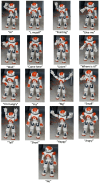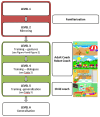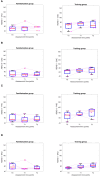Interactive mirrOring Games wIth sOCial rObot (IOGIOCO): a pilot study on the use of intransitive gestures in a sample of Italian preschool children with autism spectrum disorder
- PMID: 39006819
- PMCID: PMC11240845
- DOI: 10.3389/fpsyt.2024.1356331
Interactive mirrOring Games wIth sOCial rObot (IOGIOCO): a pilot study on the use of intransitive gestures in a sample of Italian preschool children with autism spectrum disorder
Abstract
Background: Autism Spectrum Disorder (ASD) is a neurodevelopmental disorder characterized by persistent deficits in social communication, social interaction, and restricted behaviors. The importance of early intervention has been widely demonstrated, and developmental trajectories in ASD emphasize the importance of nonverbal communication, such as intransitive gesture production, as a possible positive prognostic factor for language development. The use of technological tools in the therapy of individuals with ASD has also become increasingly important due to their higher engagement and responsiveness to technological objects, such as robots.
Materials and methods: We developed a training protocol using the humanoid robot NAO, called IOGIOCO (Interactive mirroring Games wIth sOCial rObot), based on the use of intransitive gestures embedded in naturalistic dialogues, stimulating a triadic interaction between child, robot and therapist. The training was divided into six levels; the first 2 levels were called "familiarization levels," and the other 4 were "training levels". The technological setup includes different complexity levels, from mirroring tasks to building spontaneous interactions. We tested the protocol on 10 preschool children with ASD (aged 2-6 years) for 14 weeks. We assessed them at recruitment (T0), at the end of training (T1), and after 6 months (T2).
Results: We demonstrated the tolerability of the protocol. We found that one group (n=4, males and 2 females) reached the training level, while another and group (n=6 males) remained at a familiarization level (mirroring), we analyzed the results for the two groups. In the group that reached the training levels, we found promising results, such as an improvement in the Social Adaptive Domain of the ABAS-II questionnaire between T0 and T2.
Conclusion: While current results will need a Randomized Controlled Trial to be confirmed, the present work sets an important milestone in using social robots for ASD treatment, aimed at impacting social and communication skills in everyday life.
Keywords: autism spectrum disorders; children; communicative gestures; social robot; technological rehabilitation.
Copyright © 2024 Annunziata, Santos, Caglio, Geminiani, Brazzoli, Piazza, Olivieri, Pedrocchi and Cavallini.
Conflict of interest statement
The authors declare that the research was conducted in the absence of any commercial or financial relationships that could be construed as a potential conflict of interest.
Figures







Similar articles
-
Robot-based intervention may reduce delay in the production of intransitive gestures in Chinese-speaking preschoolers with autism spectrum disorder.Mol Autism. 2018 May 24;9:34. doi: 10.1186/s13229-018-0217-5. eCollection 2018. Mol Autism. 2018. PMID: 29796238 Free PMC article. Clinical Trial.
-
Development of an Interactive Total Body Robot Enhanced Imitation Therapy for ASD children.IEEE Int Conf Rehabil Robot. 2022 Jul;2022:1-6. doi: 10.1109/ICORR55369.2022.9896536. IEEE Int Conf Rehabil Robot. 2022. PMID: 36176149 Clinical Trial.
-
Early developmental trajectories of expressive vocabulary and gesture production in a longitudinal cohort of Italian infants at high-risk for Autism Spectrum Disorder.Autism Res. 2021 Jul;14(7):1421-1433. doi: 10.1002/aur.2493. Epub 2021 Mar 1. Autism Res. 2021. PMID: 33644995
-
Communication interventions for autism spectrum disorder in minimally verbal children.Cochrane Database Syst Rev. 2018 Nov 5;11(11):CD012324. doi: 10.1002/14651858.CD012324.pub2. Cochrane Database Syst Rev. 2018. PMID: 30395694 Free PMC article.
-
Social Humanoid Robots for Children with Autism Spectrum Disorders: A Review of Modalities, Indications, and Pitfalls.Children (Basel). 2022 Jun 25;9(7):953. doi: 10.3390/children9070953. Children (Basel). 2022. PMID: 35883937 Free PMC article. Review.
References
-
- Kanner L. Autistic disturbances of affective contact. Nervous Child. (1943) 2:217–50. - PubMed
-
- American Psychiatric Association . Diagnostic and statistical manual of mental disorders (DSM 5). 5th ed. United State: American Psychiatric Publishing; (2013).
LinkOut - more resources
Full Text Sources

